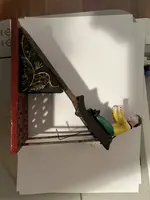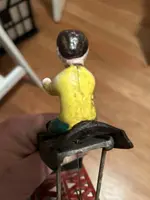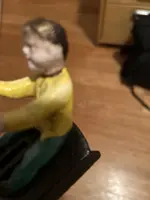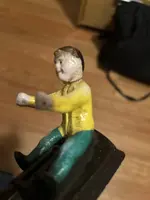You are using an out of date browser. It may not display this or other websites correctly.
You should upgrade or use an alternative browser.
You should upgrade or use an alternative browser.
Coasting bank - cast iron mechanical bank
- Thread starter pete76
- Start date
- Joined
- Aug 19, 2014
- Messages
- 39,046
- Reaction score
- 143,952
- Golden Thread
- 0
- Location
- Tarpon Springs
- Detector(s) used
- JW 8X-ML X2-VP 585
- Primary Interest:
- All Treasure Hunting
Detailed photos of the original are key..... dimensions... weight.. etc
But here is another "thing" to keep in mind and help find a key to this one....... IF there is only one known...... to copy it / repo it would be VEERY hard.
So....... Size and those things would be off.
But here is another "thing" to keep in mind and help find a key to this one....... IF there is only one known...... to copy it / repo it would be VEERY hard.
So....... Size and those things would be off.
Last edited:
Upvote
0
- Joined
- Aug 19, 2014
- Messages
- 39,046
- Reaction score
- 143,952
- Golden Thread
- 0
- Location
- Tarpon Springs
- Detector(s) used
- JW 8X-ML X2-VP 585
- Primary Interest:
- All Treasure Hunting
Again.... this is an item left to the pro's.
Christies - Sotheby's.
Christies - Sotheby's.
Upvote
0
- #23
Thread Owner
Thanks Red and Arc, I think I inadvertently found my passion! Genuinely excited either way, if it’s a reproduction then that’s fine, there’s a story there as to how and when given the ‘baby’ that sold recently, then who reproduced and how many 😁. The story and research is one that’s got me hooked
Upvote
0
- Joined
- Dec 23, 2019
- Messages
- 6,522
- Reaction score
- 20,648
- Golden Thread
- 0
- Location
- Surrey, UK
- Primary Interest:
- All Treasure Hunting
I believe the patent reference is for John Hall’s invention of 2nd February 1875, but it’s for an improvement in the coin container rather than the overall design of the money-box.

Be it known that I, JOHN HALL, of Watertown, of the county of Middlesex and State of Massachusetts, have invented a new and useful Toy Money-Box; and do hereby declare the same to be fully described in the following specification and represented in the accompanying drawings, of which Figure 1 is a front view; Fig. 2, a transverse section. Fig. 3 represents the bottom of the box, showing an opening for removing the money; and Fig. 4, a circular plate for closing said opening.
Be it known that I, JOHN HALL, of Watertown, of the county of Middlesex and State of Massachusetts, have invented a new and useful Toy Money-Box; and do hereby declare the same to be fully described in the following specification and represented in the accompanying drawings, of which Figure 1 is a front view; Fig. 2, a transverse section. Fig. 3 represents the bottom of the box, showing an opening for removing the money; and Fig. 4, a circular plate for closing said opening.
Upvote
1
- Joined
- Aug 19, 2014
- Messages
- 39,046
- Reaction score
- 143,952
- Golden Thread
- 0
- Location
- Tarpon Springs
- Detector(s) used
- JW 8X-ML X2-VP 585
- Primary Interest:
- All Treasure Hunting
After closer inspections of pictures.
I am leaning towards real..... OR a DAMN GOOD fake.
I mean really damn good.
It "looks" ......... Right as rain.
I am leaning towards real..... OR a DAMN GOOD fake.
I mean really damn good.
It "looks" ......... Right as rain.
Upvote
0
- Joined
- Aug 19, 2014
- Messages
- 39,046
- Reaction score
- 143,952
- Golden Thread
- 0
- Location
- Tarpon Springs
- Detector(s) used
- JW 8X-ML X2-VP 585
- Primary Interest:
- All Treasure Hunting
One of the FIRST "tells" are the screws.
MOST copies will have Phillips head screws.
MOST copies will have Phillips head screws.
Upvote
0
- Joined
- Aug 19, 2014
- Messages
- 39,046
- Reaction score
- 143,952
- Golden Thread
- 0
- Location
- Tarpon Springs
- Detector(s) used
- JW 8X-ML X2-VP 585
- Primary Interest:
- All Treasure Hunting
But with that said..... IF they were going to knock off this to this degree.... screws would have been the FIRST thing they made sure they copied.One of the FIRST "tells" are the screws.
MOST copies will have Phillips head screws.
So....... here we are.... again..... at the beginning

Upvote
0
- Joined
- Aug 19, 2014
- Messages
- 39,046
- Reaction score
- 143,952
- Golden Thread
- 0
- Location
- Tarpon Springs
- Detector(s) used
- JW 8X-ML X2-VP 585
- Primary Interest:
- All Treasure Hunting
Hey PEte.... I for one am rooting for ya.... and good decision to contact Sothebys.
Upvote
0
- #30
Thread Owner
Thanks Red, difficult to read but I’m getting my son to try read as he has ‘younger’ eyes 😁I believe the patent reference is for John Hall’s invention of 2nd February 1875, but it’s for an improvement in the coin container rather than the overall design of the money-box.
View attachment 2167720
Be it known that I, JOHN HALL, of Watertown, of the county of Middlesex and State of Massachusetts, have invented a new and useful Toy Money-Box; and do hereby declare the same to be fully described in the following specification and represented in the accompanying drawings, of which Figure 1 is a front view; Fig. 2, a transverse section. Fig. 3 represents the bottom of the box, showing an opening for removing the money; and Fig. 4, a circular plate for closing said opening.
Upvote
0
- Joined
- Aug 19, 2014
- Messages
- 39,046
- Reaction score
- 143,952
- Golden Thread
- 0
- Location
- Tarpon Springs
- Detector(s) used
- JW 8X-ML X2-VP 585
- Primary Interest:
- All Treasure Hunting
Thanks for keeping us posted.So, Sotheby’s not interested after reviewing images. - will ask one more auction house but doesn’t look promising
Now... are they not interested because of them thinking it is not real ? ? ?
OR... just not interested ?
Upvote
0
- #33
Thread Owner
Apparently not in their expertise or value range ? I followed up to see if it was an issue with authenticity but no response yet. I’ve sent to freeman’s as well as they sold the one posted earlierThanks for keeping us posted.
Now... are they not interested because of them thinking it is not real ? ? ?
OR... just not interested ?
Upvote
1
Tony in SC
Gold Member
- Joined
- Jun 8, 2006
- Messages
- 6,412
- Reaction score
- 9,253
- Golden Thread
- 0
- Location
- Upstate South Carolina
- Detector(s) used
- Whites, Minelab, Tesoro, and custom machines
- Primary Interest:
- Metal Detecting
I think the screws are handmade because the slots are off center?
Upvote
1
- Joined
- Aug 19, 2014
- Messages
- 39,046
- Reaction score
- 143,952
- Golden Thread
- 0
- Location
- Tarpon Springs
- Detector(s) used
- JW 8X-ML X2-VP 585
- Primary Interest:
- All Treasure Hunting
Which would lend to its authenticity.... or not. hehI think the screws are handmade because the slots are off center?
Upvote
0
- Joined
- Dec 23, 2019
- Messages
- 6,522
- Reaction score
- 20,648
- Golden Thread
- 0
- Location
- Surrey, UK
- Primary Interest:
- All Treasure Hunting
Bummer that the auction houses aren’t offering anything helpful. A few more thoughts, which may or may not be helpful.
Circa 1900, the British company John Harper & Co Ltd of Willenhall illegally produced direct copies of mechanical banks from both the Shepard Hardware Company of Buffalo, NY and the J &E Stevens Company of Cromwell, CT.
As far as I know, Harper were never bold enough to include the original maker name on their copies, but perhaps there were other companies who had no such scruples, effectively producing contemporary counterfeits rather than copies. Harper did however include the original patent references for at least the first few years of production, after which they removed the information (perhaps in fear of legal action for fraudulent use).
Harper copies can be distinguished by either the absence of the patent references (on their later production), or from minor details such as drill-tapered holes, or the use of alternative materials. This Harper copy (an early one, with a fraudulent patent reference) for example has a cast-iron coin-arm rather than the pressed steel used for the original. Sincere apologies for the ‘N-word’ and the racial stereotyping, which I show only in the interests of historical accuracy.


If yours is a copy (and bear in mind that there were contemporary copyists/counterfeiters as well as more recent ones, such that the screw types would be similar) then the producer would have needed access to an original, or detailed drawings of it. If it’s a counterfeit rather than a copy, one would have to question why the baby was replaced by the child. There’s no record of Stevens having produced a ‘child’ version but, then again, the ‘baby’ version was unknown to collectors until 1955. The fact that only one surviving example appears to exist suggests it may have been a short-lived design. Perhaps a copyist found the child easier to cast, or judged it to have a wider appeal? It can’t have been in the interests of avoiding legal action for plagiarism, otherwise why leave the original manufacturer name on it?
If it’s a more modern copy, it’s generally the case that leaving the original manufacturer name in place is ‘safe’ if the company is defunct. Stevens was bought out by Buckley Brothers of New York in 1950, so it would likely be after that date.
As I said previously, copies of banks like this have been widely-produced for collectors for many years. Here’s a couple from my collection, both produced in Taiwan and about 35 years old, although neither have any original manufacturer names or patent details as part of their castings.

Circa 1900, the British company John Harper & Co Ltd of Willenhall illegally produced direct copies of mechanical banks from both the Shepard Hardware Company of Buffalo, NY and the J &E Stevens Company of Cromwell, CT.
As far as I know, Harper were never bold enough to include the original maker name on their copies, but perhaps there were other companies who had no such scruples, effectively producing contemporary counterfeits rather than copies. Harper did however include the original patent references for at least the first few years of production, after which they removed the information (perhaps in fear of legal action for fraudulent use).
Harper copies can be distinguished by either the absence of the patent references (on their later production), or from minor details such as drill-tapered holes, or the use of alternative materials. This Harper copy (an early one, with a fraudulent patent reference) for example has a cast-iron coin-arm rather than the pressed steel used for the original. Sincere apologies for the ‘N-word’ and the racial stereotyping, which I show only in the interests of historical accuracy.
If yours is a copy (and bear in mind that there were contemporary copyists/counterfeiters as well as more recent ones, such that the screw types would be similar) then the producer would have needed access to an original, or detailed drawings of it. If it’s a counterfeit rather than a copy, one would have to question why the baby was replaced by the child. There’s no record of Stevens having produced a ‘child’ version but, then again, the ‘baby’ version was unknown to collectors until 1955. The fact that only one surviving example appears to exist suggests it may have been a short-lived design. Perhaps a copyist found the child easier to cast, or judged it to have a wider appeal? It can’t have been in the interests of avoiding legal action for plagiarism, otherwise why leave the original manufacturer name on it?
If it’s a more modern copy, it’s generally the case that leaving the original manufacturer name in place is ‘safe’ if the company is defunct. Stevens was bought out by Buckley Brothers of New York in 1950, so it would likely be after that date.
As I said previously, copies of banks like this have been widely-produced for collectors for many years. Here’s a couple from my collection, both produced in Taiwan and about 35 years old, although neither have any original manufacturer names or patent details as part of their castings.
Upvote
2
- Joined
- Aug 19, 2014
- Messages
- 39,046
- Reaction score
- 143,952
- Golden Thread
- 0
- Location
- Tarpon Springs
- Detector(s) used
- JW 8X-ML X2-VP 585
- Primary Interest:
- All Treasure Hunting
Ahhhh you must be historically correct as well as politically correct or you will be hated ... by the archies and everyone else !
:P
:P
Upvote
1
- #38
Thread Owner
So freeman’s think it’s legit and asked me to post for physical inspection - trying to see if someone in Australia can verify rather than posting in the mail !Ahhhh you must be historically correct as well as politically correct or you will be hated ... by the archies and everyone else !
:P
Upvote
2
- Joined
- Dec 23, 2019
- Messages
- 6,522
- Reaction score
- 20,648
- Golden Thread
- 0
- Location
- Surrey, UK
- Primary Interest:
- All Treasure Hunting
So freeman’s think it’s legit and asked me to post for physical inspection - trying to see if someone in Australia can verify rather than posting in the mail !
Good luck, and please keep us posted.
You might also try contacting the ‘Mechanical Bank Collectors of America’ to see if they can shed any light on your find:
https://www.mechanicalbanks.org/
There’s an email contact given as: edwinacam@aol.com
Last edited:
Upvote
1
- Joined
- Aug 19, 2014
- Messages
- 39,046
- Reaction score
- 143,952
- Golden Thread
- 0
- Location
- Tarpon Springs
- Detector(s) used
- JW 8X-ML X2-VP 585
- Primary Interest:
- All Treasure Hunting
Not so sure i would send it off without serious considerations and insurences.So freeman’s think it’s legit and asked me to post for physical inspection - trying to see if someone in Australia can verify rather than posting in the mail !
Have you tried Christies Auction ?
Upvote
0
Similar threads
- Replies
- 16
- Views
- 543
- Replies
- 2
- Views
- 245
- Replies
- 4
- Views
- 487
Users who are viewing this thread
Total: 1 (members: 0, guests: 1)





